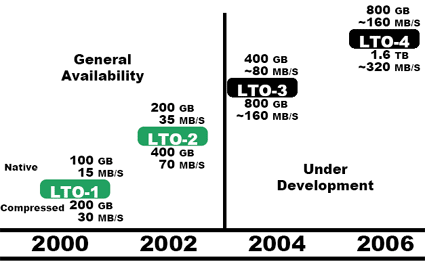The Last Resort: Streamer Technolgy Overview
ADR
Advanced Digital Recording is a standard promoted by Philips and its subsidiary On-Stream. The unique feature of this 8 mm-tape based technology is that, at all times, eight of the 192 data tracks can be written onto and read simultaneously, which results in high transfer rates at a low tape speed.
As a nice side effect, the mechanical load on the tape is remarkably low. Also, the error correction via ECC can be applied horizontally and vertically. As an example, 24 of the 192 tracks can be full of scratches or damaged otherwise, and still there is no danger that users cannot restore saved data.
Uncompressed, the ADR products available so far store 25 GB per tape. For future versions, the following improvements may be expected:
| Potential by capacity | Potential by transfer rate | ||
|---|---|---|---|
| Current | 25 GB | Row 0 - Cell 2 | 2 MB/s |
| Tape length | 2x | Tape speed | 3.6x |
| Tape width | 3x | Parallelization | 3x |
| Track density | 4x | Track density | 3x |
| Bit density | 3x | Bit density | 3x |
| Maximum (approx.) | 3.6 TB | Maximum (approx.) | 130 MB/s |
LTO
LTO (Linear Tape Open) is intended as an alternative to the DLT format made by Quantum. Its writing is linear, and numerous technical features make LTO an attractive standard, which is based on reliable technology.
The main standouts for the standard are Accelis and Ultrium, which can be licensed easily. The Ultrium standard boasts impressively high capacities and data rates.
| Header Cell - Column 0 | Ultrium-1 | Ultrium-2 | Ultrium-3 | Ultrium-4 |
|---|---|---|---|---|
| Capacity | 100 GB | 200 GB | 400 GB | 800 GB |
| Transfer Rate | 20 MB/s | 40 MB/s | 80 MB/s | 160 MB/s |
Source: ExaByte.
Get Tom's Hardware's best news and in-depth reviews, straight to your inbox.

Patrick Schmid was the editor-in-chief for Tom's Hardware from 2005 to 2006. He wrote numerous articles on a wide range of hardware topics, including storage, CPUs, and system builds.
